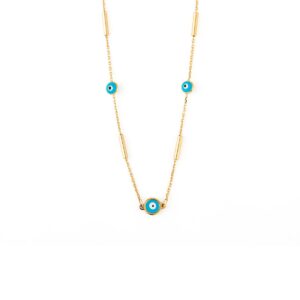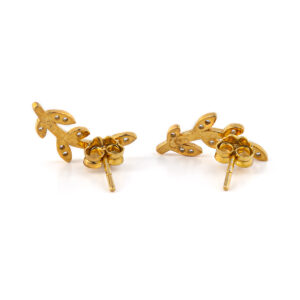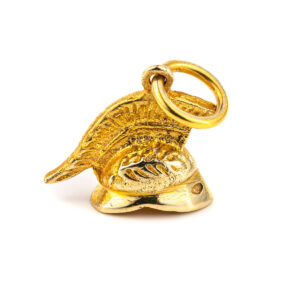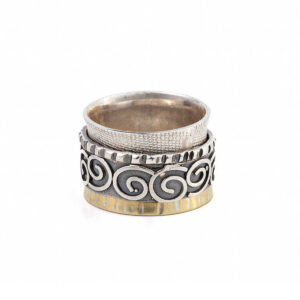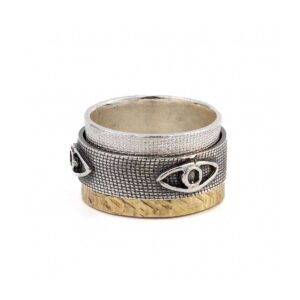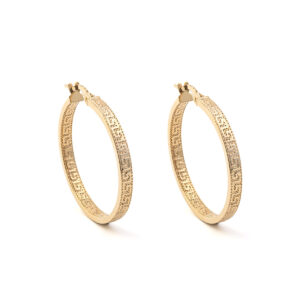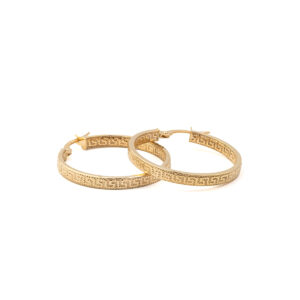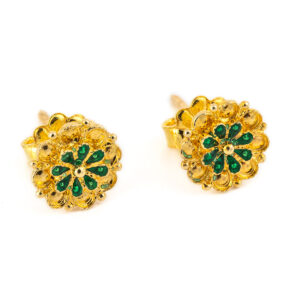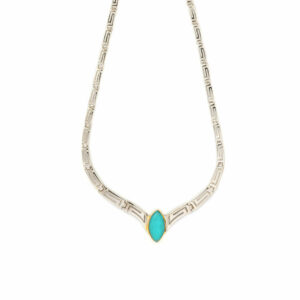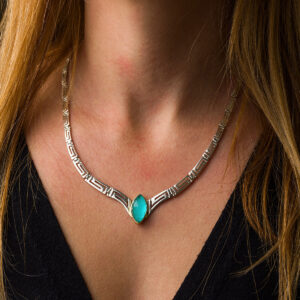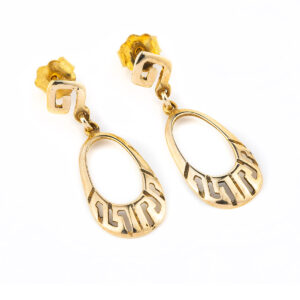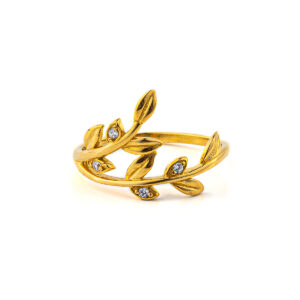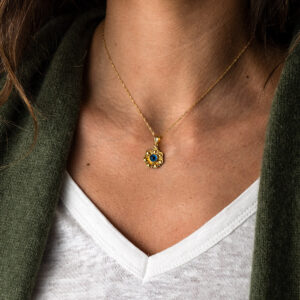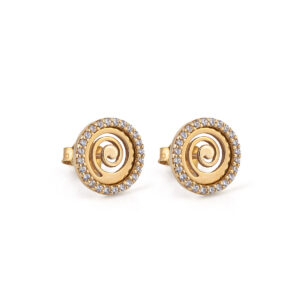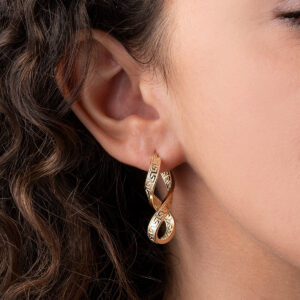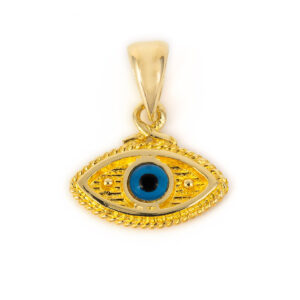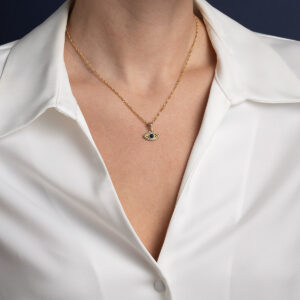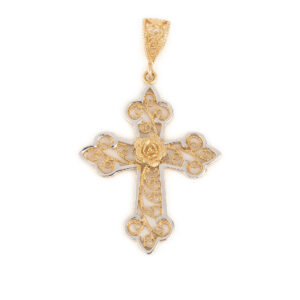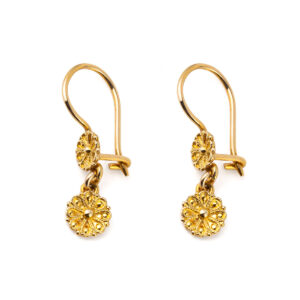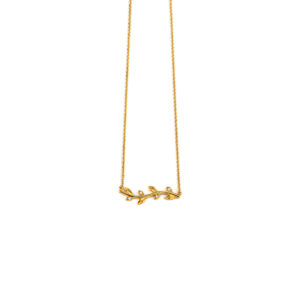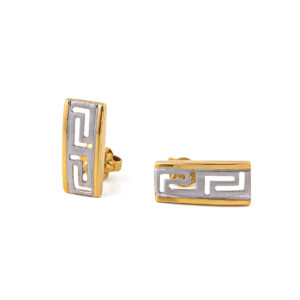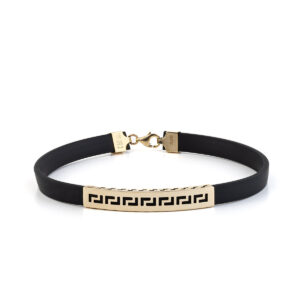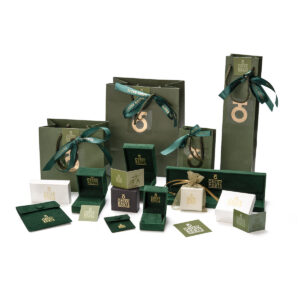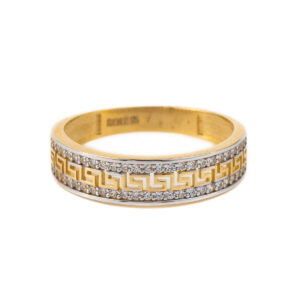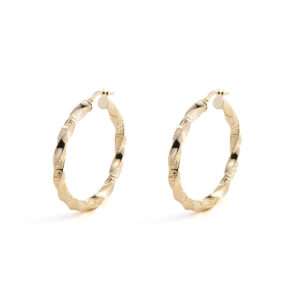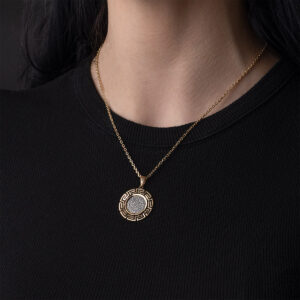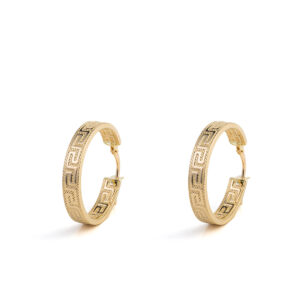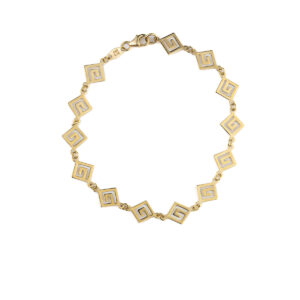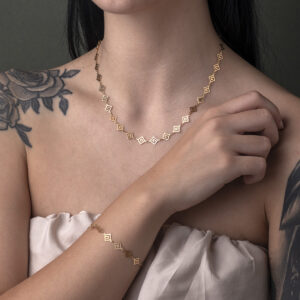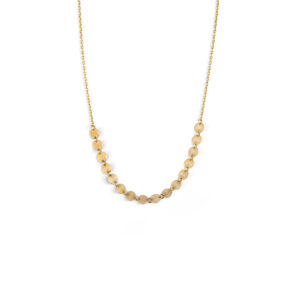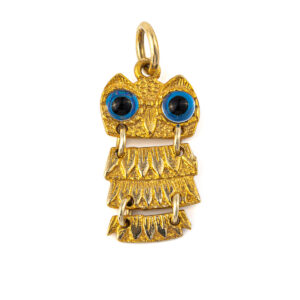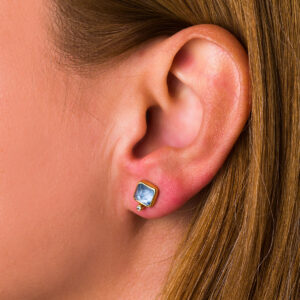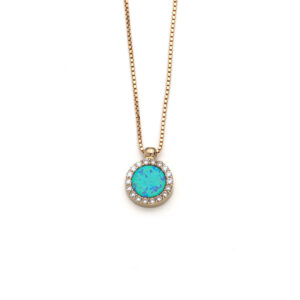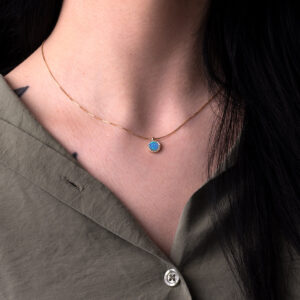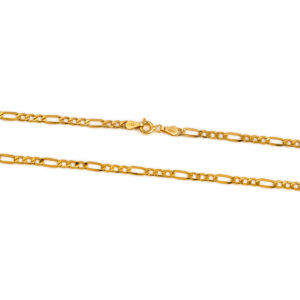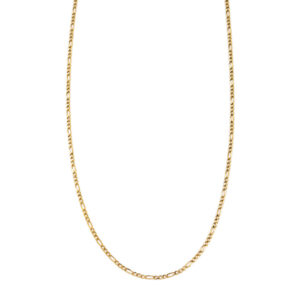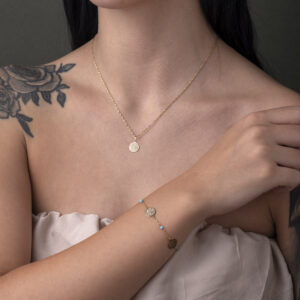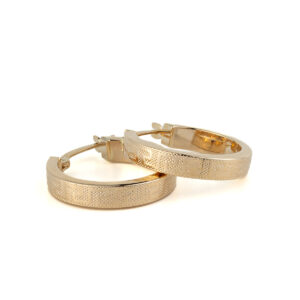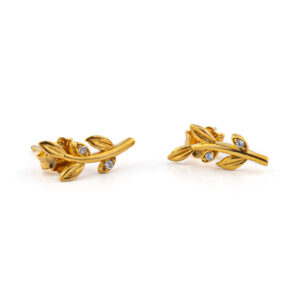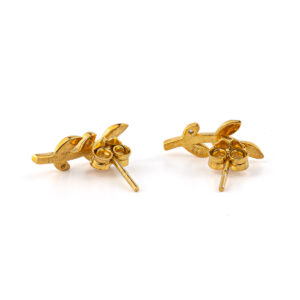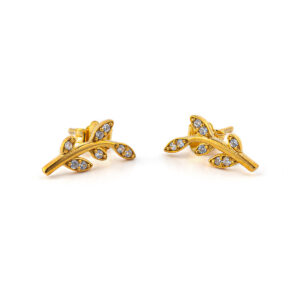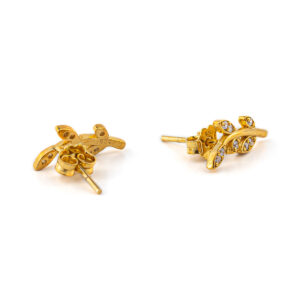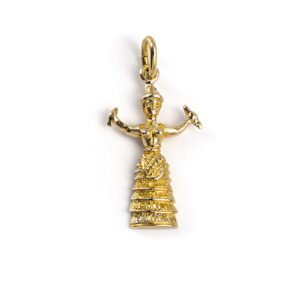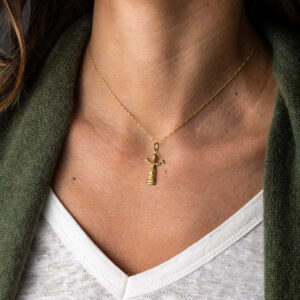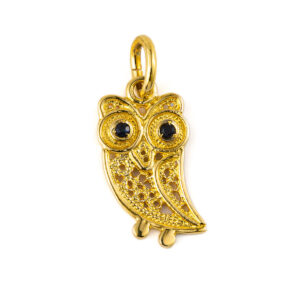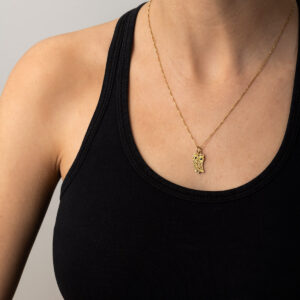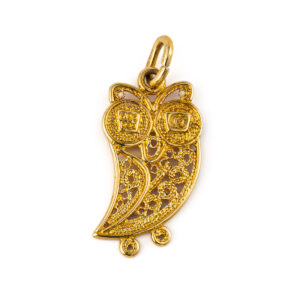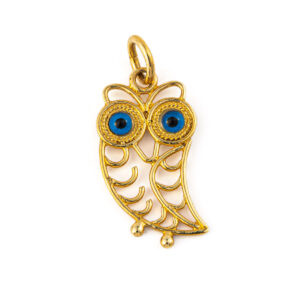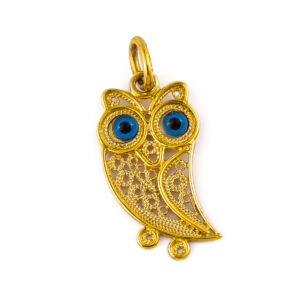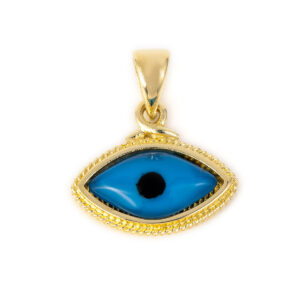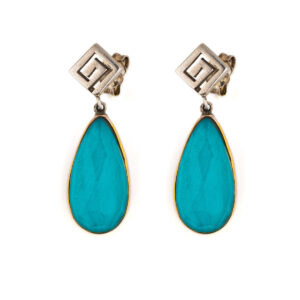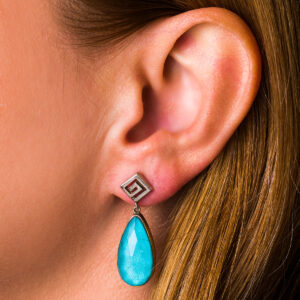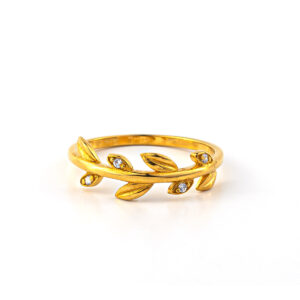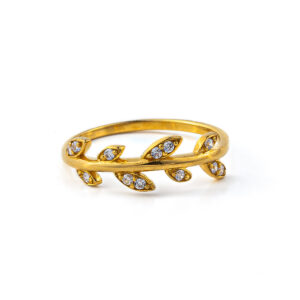Evil Eyes Necklace- 14K Gold
514,00€Made of 14K gold.
Handmade in Greece.
Explore Mati Collection
Evil Eye
The symbol and superstition of the evil eye is one of the strongest symbolic images in the world. The earliest known evidence for belief in the evil eye goes back to ancient Greece and Rome. It is supposed to wear off evil to anyone who wears it and various cultures believe in that, however in Greece it’s blue because at that time blue eyes were not so common and were thought to give the evil eye, so the blue is like a mirror to them.
Olive Leaf Zircon Earrings – 14K Solid Yellow Gold
514,00€Earrings inspired by the olive leaf symbol.
Made of 14k gold with zircon.
The olive wreath also known as kotinos was the prize for the winner at the ancient Olympic Games. It was an olive branch, of the wild- olive tree that grew at Olympia,intertwined to form a circle or a horse-shoe. According to Pausanias it was introduced by Heracles as a prize for the running race winner to honour his father Zeus. In the ancient Olympic Games there were no gold, silver, or bronze medals. There was only one winner per event, crowned with an olive wreath made of wild-olive leaves from a sacred tree near the temple of Zeus at Olympia. Olive wreaths were given out during the 2004 Summer Olympics in Athens in honor of the ancient tradition, because the games were being held in Greece.
Olive Branch Ring – 14K Solid Yellow Gold
514,00€Ring inspired by the olive leaf symbol.
Made of 14k gold.
The olive wreath also known as kotinos was the prize for the winner at the ancient Olympic Games. It was an olive branch, of the wild- olive tree that grew at Olympia, intertwined to form a circle or a horse-shoe. According to Pausanias it was introduced by Heracles as a prize for the running race winner to honour his father Zeus. In the ancient Olympic Games there were no gold, silver, or bronze medals. There was only one winner per event, crowned with an olive wreath made of wild-olive leaves from a sacred tree near the temple of Zeus at Olympia. Olive wreaths were given out during the 2004 Summer Olympics in Athens in honor of the ancient tradition because the games were being held in Greece.
Spartan Helmet Pendant – 14K Yellow Gold
514,00€Pendant with the Spartan helmet.
Made in 14k yellow gold.
The chain shown is our 14K Gold Chain in Length 40cm (not included).
Used as a charm or as a pendant.
The ancient helmets were used to protect the warriors during the war.
As in all handmade items there may be small differences in weight and dimensions and this is what makes them unique and precious.
Spiral Spinner Ring – 925 Sterling Silver and 14K Gold
Eye Spinner Ring – 925 Sterling Silver and 14K Gold
Made of 14k gold and sterling silver 925°.
Handmade in Greece.
Explore Mati Collection
Evil Eye
The symbol and superstition of the evil eye is one of the strongest symbolic images in the world. The earliest known evidence for belief in the evil eye goes back to ancient Greece and Rome. It is supposed to wear off evil to anyone who wears it and various cultures believe in that, however in Greece it’s blue because at that time blue eyes were not so common and were thought to give the evil eye, so the blue is like a mirror to them. Nowadays it’s widely known and has become a trend.
Greek Key Hoop Earrings – 14K Gold
425,00€ – 504,00€Made of 14K gold.
Handmade in Greece
Explore Meandros Collection
Meandros design is a decorative border constructed from a continuous line, shaped into a repeated motif. Such a design is also called the Greek fret or Greek key design, although these are modern designations. On the one hand, the name “meander” recalls the twisting and turning path of the Meander River in Asia Minor, and on the other hand, as Karl Kerenyi pointed out, “the meander is the figure of a labyrinth in linear form” the meaning is that there is no beginning and no end in some cases so it becomes the symbol of long life and eternity.
18K Gold Rosette Stud Earrings with Enamel
504,00€Byzantine Earrings which have the shape of the flower rosette.
Handmade with great attention to detail. Inspired by Byzantine art.
Made in 18k gold and green enamel
Rosette flower
The rosette (rose) is a timeless jewel, symbol and amulet. The origin of the term is the Greek word for rose – rodon (ρόδον). Its use began in the Mycenaean era and continues as far as the 2nd millennia BC. The Mycenaean Rosette is a motif that was widespread throughout Mesopotamia, Egypt, Greece and other ancient civilizations. It is inspired by a Mycenaean rosette bead, found at Mycenae, dated to 1400-1300 B.C. The rosette was used extensively in ancient Greek Mycenaean jewels, in architecture, pottery and in sculptures from 1500 BC. Mycenaean rosettes usually had 6 or 8 or 12 leaves, and sixteen leaves during the Macedonian Dynasty. Such details as the rodax shape and the number of leaves tend to vary with the era or beliefs. The rosettes were used to decorate the cloths, belts and wreaths of the Kings. The number of leaves had a symbolic character each time. The four elements of nature (wind, earth, fire, water), the seven wonders of the ancient world or the twelve gods of ancient Greeks and the world domination and radiance of the Kings of Macedonia. They were signs of beauty, purity, eugenics, worship and power. Rosette or Rodax was probably the most popular and favorite decorative element in Mycenaean era, classical antiquity and Byzantine times.
Greek Key Necklace with Amazonite – 14K Gold and 925 Sterling Silver
This stunning necklace features an amazonite stone.
Made of 925 sterling silver and 14k gold.
Handmade item. As in all handmade items there may be small differences in weight and dimensions and this is what makes them unique and precious.
14k Gold Meander Earrings
495,00€Made in 14k gold.
Explore Meandros Collection
Meandros design is a decorative border constructed from a continuous line, shaped into a repeated motif. Such a design is also called the Greek fret or Greek key design, although these are modern designations. On the one hand, the name “meander” recalls the twisting and turning path of the Meander River in Asia Minor, and on the other hand, as Karl Kerenyi pointed out, “the meander is the figure of a labyrinth in linear form” the meaning is that there is no beginning and no end in some cases so it becomes the symbol of long life and eternity.
Leaf Zircon Ring – 14K Solid Yellow Gold
494,00€Ring inspired by the olive leaf symbol.
Made of 14k gold with zircon.
The olive wreath also known as kotinos was the prize for the winner at the ancient Olympic Games. It was an olive branch, of the wild- olive tree that grew at Olympia, intertwined to form a circle or a horse-shoe. According to Pausanias it was introduced by Heracles as a prize for the running race winner to honour his father Zeus. In the ancient Olympic Games there were no gold, silver, or bronze medals. There was only one winner per event, crowned with an olive wreath made of wild-olive leaves from a sacred tree near the temple of Zeus at Olympia. Olive wreaths were given out during the 2004 Summer Olympics in Athens in honor of the ancient tradition because the games were being held in Greece.
Mycenaean Rosette Flower Pendant with Evil Eye symbol in 14K Gold
278,00€ – 494,00€Mycenaean Rosette Flower Pendant with Evil Eye symbol in 14K Gold
Handmade with great attention to detail. Inspired by the Ancient Greek history.
The chain shown is our 14K Gold Chain in Length 40cm (not included).
Evil Eye
The symbol and superstition of the evil eye is one of the strongest symbolic images in the world. The earliest known evidence for belief in the evil eye goes back to ancient Greece and Rome. It is supposed to wear off evil to anyone who wears it and various cultures believe in that, however in Greece it’s blue because at that time blue eyes were not so common and were thought to give the evil eye, so the blue is like a mirror to them. Nowadays it’s widely known and has become a trend.
Rosette flower
The rosette (rose) is a timeless jewel, symbol and amulet. The origin of the term is the Greek word for rose – rodon (ρόδον). Its use began in the Mycenaean era and continues as far as the 2nd millennia BC. The Mycenaean Rosette is a motif that was widespread throughout Mesopotamia, Egypt, Greece and other ancient civilizations. It is inspired by a Mycenaean rosette bead, found at Mycenae, dated to 1400-1300 B.C. The rosette were used extensively in ancient Greek Mycenaean jewels, in architecture, pottery and in sculptures from 1500 BC. Mycenaean rosettes usually had 6 or 8 or 12 leaves, and sixteen leaves during the Macedonian Dynasty. Such details as the rodax shape and the number of leaves tend to vary with the era or beliefs. The rosettes were used to decorate the cloths, belts and wreaths of the Kings. The number of leaves had a symbolic character each time. The four elements of nature (wind, earth, fire, water), the seven wonders of the ancient world or the twelve gods of ancient Greeks and the world domination and radiance of the Kings of Macedonia. They were signs of beauty, purity, eugenics, worship and power. Rosette or Rodax was probably the most popular and favorite decorative element in Mycenaean era, classical antiquity and Byzantine times.
Spiral Stud Earrings – 14K Solid Yellow Gold
492,00€Made of 14k gold with zircon.
Handmade in Greece.
Explore Spiral Collection
The spiral is one of the oldest symbols of human spirituality, carved or painted into rocks from thousands of years ago. Symbol of movement and progressive development, growth, expansion, cosmic energy, symbol of the sun. Spirals have been found in burial sites, in vases, in jewelry, clothing, weapons… They can be seen in every aspect of nature, like the tides in the oceans, the winds, the plants, the shells. The spiral phenomenon has been explained through mathematics from the time of Archimedes, the great Greek mathematician.
Meander Earrings – 14K Gold
492,00€Made of 14K gold. Handmade in Greece
Explore Meandros Collection
Meandros design is a decorative border constructed from a continuous line, shaped into a repeated motif. Such a design is also called the Greek fret or Greek key design, although these are modern designations. On the one hand, the name “meander” recalls the twisting and turning path of the Meander River in Asia Minor, and on the other hand, as Karl Kerenyi pointed out, “the meander is the figure of a labyrinth in linear form” the meaning is that there is no beginning and no end in some cases so it becomes the symbol of long life and eternity.
Leaf Zircon Necklace – 14k Yellow Gold
492,00€Made in 14K gold with zircon.
A necklace inspired by the olive branch, a symbol of peace, abundance and achievement.
Handmade item.
Evil Eye Pendant – 14K Gold
258,00€ – 492,00€Evil Eye Pendant with granules of precious metal
Handmade with great attention to detail. Inspired by the Byzantine Historical period respecting Greek art.
Made in 14k gold.
Evil Eye The symbol and superstition of the evil eye is one of the strongest symbolic images in the world. The earliest known evidence for belief in the evil eye goes back to ancient Greece and Rome. It is supposed to wear off evil to anyone who wears it and various cultures believe in that, however in Greece it’s blue because at that time blue eyes were not so common and were thought to give the evil eye, so the blue is like a mirror to them. Nowadays it’s widely known and has become a trend.
Granulation (from Latin: granum = “grain”) is a jewellery technique whereby a surface of a jewel is covered with small spheres or granules of precious metal. The technique is thought to have its origins in Mesopotamia about 5,000 years ago.
Byzantine Cross in 14K Gold with Rose
492,00€Byzantine Cross in 14K Gold with Rose
Inspired by Byzantine art.
Made in 14k gold
Handmade item
18K Gold Byzantine Rosette Earrings
489,00€Byzantine earrings with the shape of a flower rosette.
Handmade with great attention to detail. Inspired by Byzantine art.
Made in 18k gold.
Handmade item.
Explore Byzantine Collection
Rosette flower
The rosette (rose) is a timeless jewel, symbol, and amulet. The origin of the term is the Greek word for rose – rodon (ρόδον). Its use began in the Mycenaean era and continues as far as the 2nd millennium BC. The Mycenaean Rosette is a motif that was widespread throughout Mesopotamia, Egypt, Greece, and other ancient civilizations. It is inspired by a Mycenaean rosette bead, found at Mycenae, dated to 1400-1300 B.C. The rosette was used extensively in ancient Greek Mycenaean jewels, in architecture, pottery, and sculptures from 1500 BC. Mycenaean rosettes usually had 6 or 8 or 12 leaves, and sixteen leaves during the Macedonian Dynasty. Such details as the rodax shape and the number of leaves tend to vary with the era or beliefs. The rosettes were used to decorate the clothes, belts, and wreaths of the Kings. The number of leaves had a symbolic character each time. The four elements of nature (wind, earth, fire, water), the seven wonders of the ancient world or the twelve gods of ancient Greeks, and the world domination and radiance of the Kings of Macedonia. They were signs of beauty, purity, eugenics, worship, and power. Rosette or Rodax was probably the most popular and favorite decorative element in Mycenaean era, classical antiquity and Byzantine times.
Leaf Necklace with Zircon – 14k Yellow Gold
475,00€Made in 14K gold with zircon.
A necklace inspired by the olive branch, a symbol of peace, abundance and achievement.
Handmade item.
Meander Stud Earrings – 14K Solid Yellow Gold
472,00€Made of 14K gold.
Handmade in Greece
Explore Meandros Collection
Meandros design is a decorative border constructed from a continuous line, shaped into a repeated motif. Such a design is also called the Greek fret or Greek key design, although these are modern designations. On the one hand, the name “meander” recalls the twisting and turning path of the Meander River in Asia Minor, and on the other hand, as Karl Kerenyi pointed out, “the meander is the figure of a labyrinth in linear form” the meaning is that there is no beginning and no end in some cases so it becomes the symbol of long life and eternity.
Greek Key Bracelet – 14K Gold
472,00€Βracelet with continuous Greek key design the which symbolizes long life and eternity.
A meander or meandros is a decorative border constructed from a continuous line, shaped into a repeated motif. Such a design is also called the Greek fret or Greek key design, although these are modern designations. On the one hand, the name “meander” recalls the twisting and turning path of the Meander River in Asia Minor, and on the other hand the meander is the figure of a labyrinth in linear form. Meander was among the most important symbols in ancient Greece; they, perhaps, symbolized infinity and unity; many ancient Greek temples incorporated the sign of the meander.
Made of 14k gold.
Handmade item
14k Gold Meander Ring with white crystals
472,00€Meander Ring in 14k Gold with white crystals inspired by the ancient Greek design the Meander or Greek Key.
Meandros design is a decorative border constructed from a continuous line, shaped into a repeated motif. Such a design is also called the Greek fret or Greek key design, although these are modern designations. On the one hand, the name “meander” recalls the twisting and turning path of the Meander River in Asia Minor, and on the other hand, as Karl Kerenyi pointed out, “the meander is the figure of a labyrinth in linear form” the meaning is that there is no beginning and no end in some cases so it becomes the symbol of long life and eternity.
Handmade item.
14K Gold Filigree Byzantine Evil Eye Pendant
278,00€ – 471,00€Evil Eye Pendant embellished with a fine filigree.
Handmade with great attention to detail.
Inspired by the Byzantine Historical period respecting Greek art.
Made in 14k gold.
Evil Eye
The symbol and superstition of the evil eye is one of the strongest symbolic images in the world. The earliest known evidence for belief in the evil eye goes back to ancient Greece and Rome. It is supposed to wear off evil to anyone who wears it and various cultures believe in that, however in Greece it’s blue because at that time blue eyes were not so common and were thought to give the evil eye, so the blue is like a mirror to them.
Filigree is a delicate kind of jewellery metalwork, made with tiny beads or twisted threads, or both in combination, soldered together or to the surface of an object of the same metal and arranged in artistic motifs. The art of filigree dates back to ancient history. The first of the found jewelry in this technique has been found in Mesopotamia and dates to thousands of years BC. In the ancient world and particularly in Asia Minor, this art grew at the highest level.
Greek Key Hoop Earrings in 14K Gold
469,00€Made of 14K gold. Handmade in Greece
Explore Meandros Collection
Meandros design is a decorative border constructed from a continuous line, shaped into a repeated motif. Such a design is also called the Greek fret or Greek key design, although these are modern designations. On the one hand, the name “meander” recalls the twisting and turning path of the Meander River in Asia Minor, and on the other hand, as Karl Kerenyi pointed out, “the meander is the figure of a labyrinth in linear form” the meaning is that there is no beginning and no end in some cases so it becomes the symbol of long life and eternity.
Eternity Ring – 14K Yellow Gold
452,00€Made of 14k gold.
Handmade in Greece
The collection contains jewelry with beautiful zircon stones.
Phaistos Disk 14K Gold Coin Pendant Meander Bezel
450,00€A pendant inspired by the ancient disk found in Phaistos.
Made of 925⁰ sterling silver and 14k gold.
Handmade in Greece.
The chain shown in the second picture is our Rollo Chain – 14K Gold ( not included).
Explore Phaistos Disc Collection
History
The Phaistos Disc is a disk of fired clay from the Minoan palace of Phaistos on the island of Crete. Now, the island of Crete is part of modern Greece. The disc was discovered in 1908 by the Italian archaeologist Luigi Pernier in the Minoan palace-site of Phaistos. While it is not clear that it is a script, most attempted decipherments assume that it is; most additionally assume a syllabary, others an alphabet or logography or a calendar.
Greca Hoop Earrings – Gold 14K
449,00€Made of 14K gold. Handmade in Greece
Explore Meandros Collection
Meandros design is a decorative border constructed from a continuous line, shaped into a repeated motif. Such a design is also called the Greek fret or Greek key design, although these are modern designations. On the one hand, the name “meander” recalls the twisting and turning path of the Meander River in Asia Minor, and on the other hand, as Karl Kerenyi pointed out, “the meander is the figure of a labyrinth in linear form” the meaning is that there is no beginning and no end in some cases so it becomes the symbol of long life and eternity.
Greek Key Bracelet in Gold
449,00€Made of 14K yellow gold
Handmade in Greece
Explore Meandros Collection
Meandros design is a decorative border constructed from a continuous line, shaped into a repeated motif. Such a design is also called the Greek fret or Greek key design, although these are modern designations. On the one hand, the name “meander” recalls the twisting and turning path of the Meander River in Asia Minor, and on the other hand, as Karl Kerenyi pointed out, “the meander is the figure of a labyrinth in linear form” the meaning is that there is no beginning and no end in some cases so it becomes the symbol of long life and eternity.
Wisdom Owl Pendant – 14K Gold
449,00€This pendant is inspired by the Ancient Greek jewels which represent the symbol of the Wisdom Owl.
Made in 14k gold.
Owl of Athena
In Greek mythology, a little owl traditionally represents or accompanies Athena, the virgin goddess of wisdom. Because of such association, the bird – often referred to as the «owl of Athena» has been used as a symbol of knowledge, wisdom, perspicacity and erudition.
Blue Topaz Earrings – 18K Gold and Sterling Silver
440,00€These earrings features a beautiful blue topaz gemstone
Made of 18K gold and 925°sterling silver.
Handmade in Greece
As in all handmade items there may be small differences in weight, dimensions and this is what makes them unique and precious.
Explore Ionian Colors Collection
The collection contains jewelry with unique semi precious stones in beautiful colors.
Gourmet Chain 14K Gold – 40 cm
437,00€The pendant shown is our Filigree Egg Pendant with Flowers (not included).
Also shown
14K Gold and Blue Enamel Goddess Athena Coin Pendant
Phaistos Disc Bracelet – 14K Gold
428,00€This beautiful bracelet with Phaistos discs. The Phaistos Disc is a disk of fired clay from the Minoan palace of Phaistos on the island of Crete. Now, the island of Crete is part of modern Greece. The disc was discovered in 1908 by the Italian archaeologist Luigi Pernier in the Minoan palace-site of Phaistos. While it is not clear that it is a script, most attempted decipherments assume that it is; most additionally assume a syllabary, others an alphabet or logography or a calendar.
Made in 14K gold.
Handmade item.
Explore Phaistos Disc Collection
Greca Hoop Earrings – 14K Gold
278,00€ – 428,00€These hoop earrings are enriched with an engraved Greek Key pattern.
Handmade in Greece
Explore Meandros Collection
Meandros design is a decorative border constructed from a continuous line, shaped into a repeated motif. Such a design is also called the Greek fret or Greek key design, although these are modern designations. On the one hand, the name “meander” recalls the twisting and turning path of the Meander River in Asia Minor, and on the other hand, as Karl Kerenyi pointed out, “the meander is the figure of a labyrinth in linear form” the meaning is that there is no beginning and no end in some cases so it becomes the symbol of long life and eternity.
Olive Leaf Earrings with Zircon – 14K Solid Yellow Gold
428,00€Earrings inspired by the olive leaf symbol.
Made of 14k gold with zircon.
The olive wreath also known as kotinos was the prize for the winner at the ancient Olympic Games. It was an olive branch, of the wild- olive tree that grew at Olympia,intertwined to form a circle or a horse-shoe. According to Pausanias it was introduced by Heracles as a prize for the running race winner to honour his father Zeus. In the ancient Olympic Games there were no gold, silver, or bronze medals. There was only one winner per event, crowned with an olive wreath made of wild-olive leaves from a sacred tree near the temple of Zeus at Olympia. Olive wreaths were given out during the 2004 Summer Olympics in Athens in honor of the ancient tradition, because the games were being held in Greece.
Leaf Earrings with Zircon – 14K Solid Yellow Gold
428,00€Earrings inspired by the olive leaf symbol.
Made of 14k gold with zircon.
The olive wreath also known as kotinos was the prize for the winner at the ancient Olympic Games. It was an olive branch, of the wild- olive tree that grew at Olympia,intertwined to form a circle or a horse-shoe. According to Pausanias it was introduced by Heracles as a prize for the running race winner to honour his father Zeus. In the ancient Olympic Games there were no gold, silver, or bronze medals. There was only one winner per event, crowned with an olive wreath made of wild-olive leaves from a sacred tree near the temple of Zeus at Olympia. Olive wreaths were given out during the 2004 Summer Olympics in Athens in honor of the ancient tradition, because the games were being held in Greece.
14k Gold Snake Goddess Pendant
428,00€Pendant inspired by the Minoan jewellery.
Made in 14k gold.
The chain shown is our 14K Gold Chain in Length 40cm (not included).
Explore Heritage Collection
History
Snake goddess is a type of figurine depicting a woman holding a snake in each hand, as found in Minoan archaeological sites in Crete. The first two of such figurines were found by the British archaeologist Arthur Evans and date to the Minoan civilization. Symbol of birth, fertility, death and rebirth not only of humans but also of the universe.
Wisdom Owl Filigree Pendant – 14K Gold with Sapphire
257,00€ – 428,00€This pendant is inspired by the Ancient Greek jewels which represent the symbol of the Wisdom Owl.
Made in 14k gold.
Owl of Athena
In Greek mythology, a little owl traditionally represents or accompanies Athena, the virgin goddess of wisdom. Because of such association, the bird – often referred to as the «owl of Athena» has been used as a symbol of knowledge, wisdom, perspicacity and erudition.
The model is wearing size Small.
The chain shown is our 14K Gold Box Chain (not included).
Wisdom Owl Filigree Pendant – 14K Gold
428,00€This pendant is inspired by the Ancient Greek jewels which represent the symbol of the Wisdom Owl.
Made in 14k gold. The pendant is embellished with a fine filigree.
Owl of Athena
In Greek mythology, a little owl traditionally represents or accompanies Athena, the virgin goddess of wisdom. Because of such association, the bird – often referred to as the «owl of Athena» has been used as a symbol of knowledge, wisdom, perspicacity and erudition.
14k Gold Filigree Pendant – Wisdom Owl with Blue Eyes
428,00€Wisdom Owl Pendant embellished with a fine filigree.
Made in 14k gold. As in all handmade items there may be small differences in weight and dimensions and this is what makes them unique and precious.
14k Solid Gold Filigree Pendant – Wisdom Owl
428,00€Wisdom Owl Pendant embellished with a fine filigree.
Made in 14k gold.
Evil Eye Pendant in 14K Gold
428,00€Handmade with great attention to detail.
Inspired by the Byzantine Historical period respecting Greek art.
Made in 14k gold.
Evil Eye
The symbol and superstition of the evil eye is one of the strongest symbolic images in the world. The earliest known evidence for belief in the evil eye goes back to ancient Greece and Rome. It is supposed to wear off evil to anyone who wears it and various cultures believe in that, however in Greece it’s blue because at that time blue eyes were not so common and were thought to give the evil eye, so the blue is like a mirror to them.
Amazonite Dangle Earrings – 18K Gold and Sterling Silver
These earrings feature a beautiful Amazonite gemstone
Made of 18K gold and 925°sterling silver.
Handmade item. As in all handmade items, there may be small differences in weight and dimensions and this is what makes them unique and precious.
Leaf Zircon Ring – 14K Solid Yellow Gold
418,00€Ring inspired by the olive leaf symbol.
Made of 14k gold with zircon.
The olive wreath also known as kotinos was the prize for the winner at the ancient Olympic Games. It was an olive branch, of the wild- olive tree that grew at Olympia, intertwined to form a circle or a horse-shoe. According to Pausanias it was introduced by Heracles as a prize for the running race winner to honour his father Zeus. In the ancient Olympic Games there were no gold, silver, or bronze medals. There was only one winner per event, crowned with an olive wreath made of wild-olive leaves from a sacred tree near the temple of Zeus at Olympia. Olive wreaths were given out during the 2004 Summer Olympics in Athens in honor of the ancient tradition because the games were being held in Greece.
Leaf Ring with Zircon – 14K Solid Yellow Gold
418,00€Ring inspired by the olive leaf symbol.
Made of 14k gold with zircon.
The olive wreath also known as kotinos was the prize for the winner at the ancient Olympic Games. It was an olive branch, of the wild- olive tree that grew at Olympia, intertwined to form a circle or a horse-shoe. According to Pausanias it was introduced by Heracles as a prize for the running race winner to honour his father Zeus. In the ancient Olympic Games there were no gold, silver, or bronze medals. There was only one winner per event, crowned with an olive wreath made of wild-olive leaves from a sacred tree near the temple of Zeus at Olympia. Olive wreaths were given out during the 2004 Summer Olympics in Athens in honor of the ancient tradition because the games were being held in Greece.

